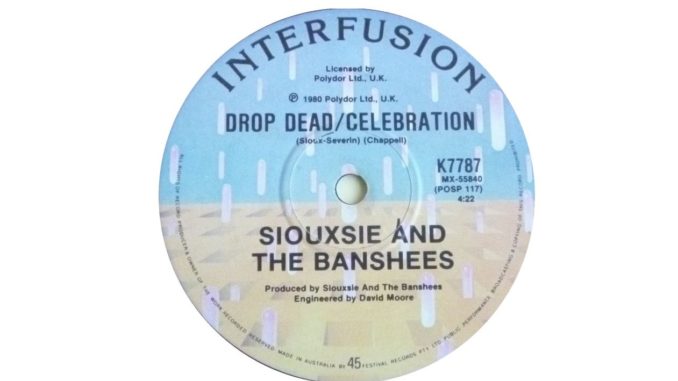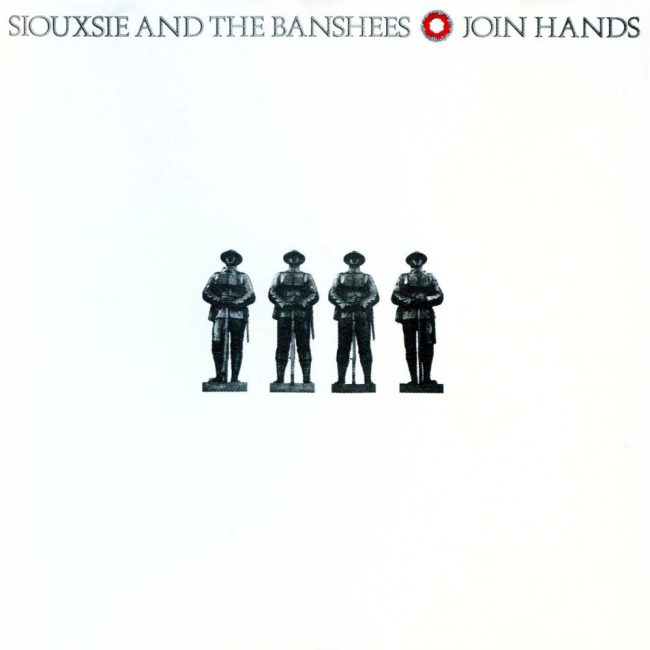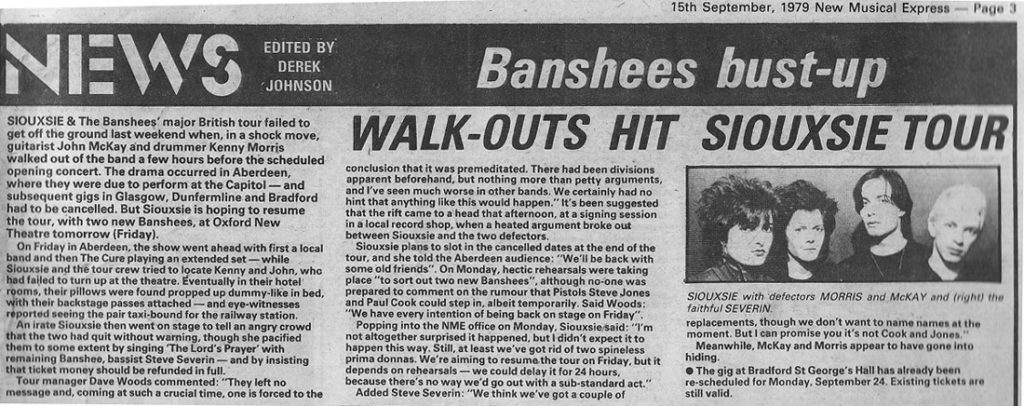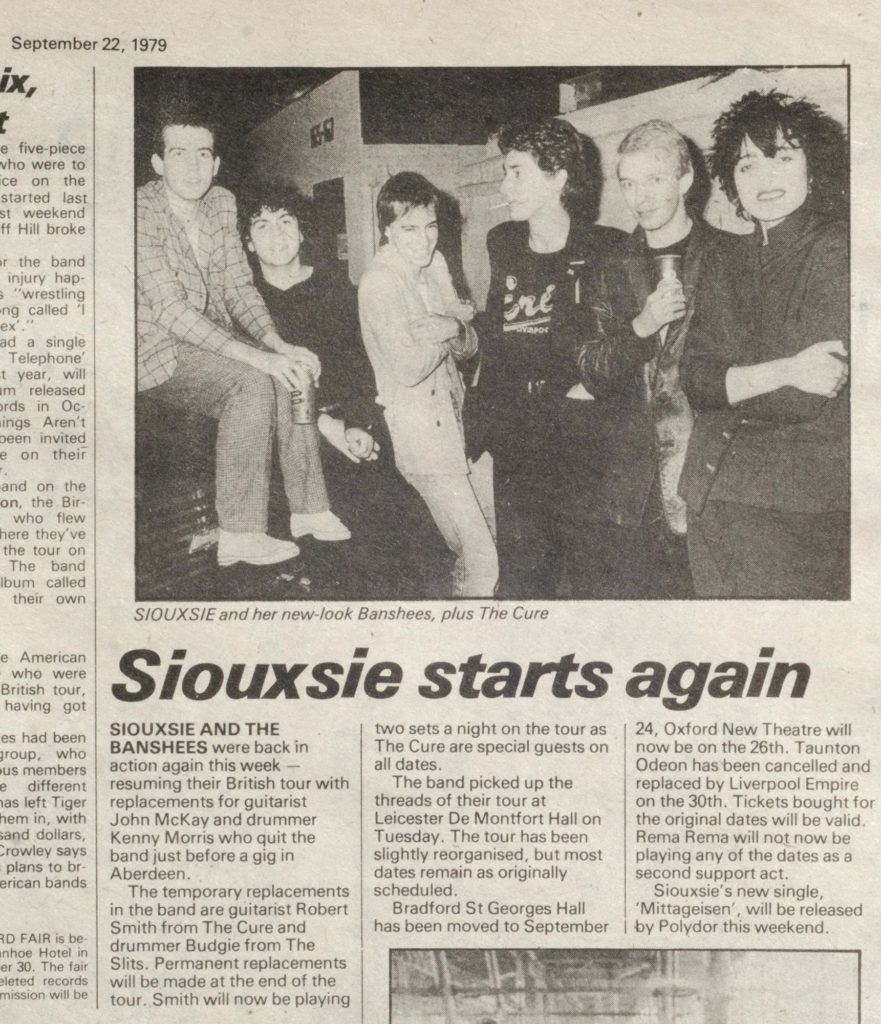
Some stories tick several boxes. This one fits perfectly well in the “story behind the song” category, but at the same time, this is a “rock’n’roll war story” if I ever heard one.
A band should be a tightly knit unit, even though band relationships change. Typically, in the early part of their career, a band will often be like brothers and sisters. They will fight from time to time, but also slog through it all together and ultimately have each other’s backs. Later on, as people get families and a life outside of the band, relationships may shift more towards being work colleagues and even just straight business partners. You don’t need to be friends or socialise outside of the band, but you still need to at the very least be able to work together.
That is not always possible. Now and then, things fall apart. Occasionally, they fall apart quite badly. Fortunately, things rarely turn as ugly as it did for Siouxsie and the Banshees in 1979.

At that time, the band had just released their second album Join Hands. They had gotten some good press and were embarking on a major tour to promote the album with The Cure as the opening band. Things were looking promising from the outside, but behind the scenes, it was all slowly unravelling.
In reality, a split had formed down the middle, with founding members Siouxsie Sioux (vocals) and Steven Severin (bass) increasingly finding themselves at odds with Kenny Morris (drums) and John McKay (guitar). Manager Nils Stevenson was not helping as he was playing favourites with Sioux and Severin, making matters worse.
Things had intensified when Mike Stavrou was chosen as producer for the recording sessions leading into the Join Hands album. Morris and McKay did not feel he was a good choice artistically as he was not into what the band was doing. It didn’t help when the producer sussed out who was buttering his bread, and started favouring input from Sioux and Severin.
Bizarrely, manager Stevenson also decided to insert himself into the production team, which made matters even worse. McKay especially did not take kindly to the manager starting to tell him how to play and getting involved artistically. Song writing input from McKay and Morris was minimised. The band did not come out of those album sessions in good shape, even though the album got good reviews and kept building on the first one.
Consequently, McKay and Morris started dragging their feet. They would turn up late for things. The very last photo session they did together was memorable for all the wrong reasons. In the official band biography, Severin tells “you can tell from the pictures that they’re not enjoying it, because they both look stoned and pissed off. They hadn’t been party to the decision to do the shoot and had been told to come along. That probably made them feel even more excluded, but it wasn’t like we consciously decided to annoy them. I wish they’d been more forceful and that we’d been able to have a huge row, but there was nothing like that. They just sulked quietly.”
The tour that followed was fraught with difficulties, and matters had to come to a head. It finally did, on a fateful Saturday morning, on 8 September 1979, during a record signing at The Other Record Shop in Aberdeen.
Yet again, not all band members had been told that the record signing was happening. In what had become a pattern, Morris and McKay was more or less told to show up on short notice. The vibe was tense at that point.
As the band walked in, the record shop was playing their new album Join Hands. Guitarist McKay had started strongly disliking the record and did not feel like being subjected to it again, so he took it off. Instead, he put on the new album by The Slits, which also had come out that same week. Sioux was not happy, words were exchanged, and everything started going from bad to worse.
The band was amazingly able to focus on the signing and it got underway, but it was a fiasco right from the start. There were loads of people waiting to get the new album signed, but Polydor had done a mistake and failed to supply the shop with enough records. The band were having to sign copies of Scream (the debut album) and the singles instead. That is, until manager Stevenson got one of his brilliant ideas.
As it happened, the band had a box of promotional copies of the album in their van, stamped with “Promotional copy – not for sale” on the front in golden letters. And indeed, those records were brought for the band to hand out copies to key people as they made their way around the tour, not to be sold in shops. Still, as there were fans wanting to buy the record, the manager brought in that box of promos and they started selling them.
McKay and Morris took great exception to this, feeling that these records were meant to be given away. They started handing them out to people.
That’s when Sioux reached her boiling point. Depending on who you ask, she either punched or shoved McKay.
For the record, in the official band biography Sioux refers to it as a shove rather than a punch. McKay, however, has always been very clear that he was punched. Sioux had a well-documented reputation in those early days for being very quick to anger and quite aggressive if she felt wronged. Whatever she did was done in anger, with aggression, and very likely well felt. She later described this aspect of her personality as, “others might seethe more. With me, I just explode and smash something, then it’s over.”
So, push or punch? I don’t think it matters. What’s the difference between an aggressive push and a punch? What happened probably lies somewhere inside that question, but the way things were at that point, the gentle touch of a feather duster would probably have had the same effect.
McKay stood there in stunned silence for a while. He looked over at drummer Kenny Morris, and without a word the two of them just walked out. They would never return to duty for the Banshees.
McKay would later describe the incident as “the last straw” rather than a reason in itself to leave the band – the two of them simply felt that enough was enough. The band was not in a healthy place. Something had to give. It could have happened a number of times in the weeks and months leading up to that point.
When Sioux and Severin turned up for sound check later, they fully expected to see their two bandmates there. They figured they had gone to clear their heads, to get some air and calm down. When they found that they were the only ones there, they understood that this incarnation of the Banshees was over.
McKay and Morris did indeed go out to clear their heads, but instead of going to the sound check they returned to the hotel to pack. They timed it to when they knew the others would be at the venue as they had no desire to see them.
They had checked out of the hotel and gotten inside a taxi when manager extraordinaire Nils Stevenson turned up. “I’ve invested 45,000 pounds in this tour!” he shouted at them, perhaps showing where his real concern was. He reached in though the taxi window, grabbing Morris (the closest one) by the neck as if to strangle him, screaming “You will never work again! You will never work again!” Which, as McKay put it in a TV interview years later, “that was really the last of our worries at that point. We had no choice but to roll up the window and drive off with Nils hanging on for a bit, which he did whether we wanted him to or not.”
The tirade of abuse was lost in the absurdity of their now ex-manager being dragged after the taxi for a bit. “I was just pleased to see him in some agony!” McKay later said with a smile.
Sioux still shakes her head about what happened. “They flushed the whole thing down the toilet, basically. It’s such a shitty thing to do to anyone. Let alone someone you practically lived with for two years.”
Morris knew that Sioux was not going to let them go quietly. In a TV interview he recalled their journey out of Aberdeen: “I told John that we would not be going to the station. Why? Because that was the first place Siouxsie would look, and I knew her. I knew she would be going there, looking through every carriage on the rampage, and she would search under every seat. And, she did!”
In a separate interview for the same TV programme, Sioux added, “if I had been out to get my hands on either of them, I am sure I would have come close to throttling the life out of them.”
The show that evening actually went on. Sioux and Severin were intent on going out in front of their fans and do or say something, although they were not sure what. The crowd had an inkling that something was wrong early on. Word of mouth from the signing was spreading, and The Cure was playing quite an extended show for an opening act.
Eventually, Sioux and Severin went on to explain what had happened – that they were ready to play, but that the other two had scarpered. They offered anyone who wanted to leave their money back. For those who stayed (by all accounts, most of the audience) they ended up playing quite an extended version of The Lord’s Prayer with Robert Smith on guitar.
Severin: “I think it was Robert Smith who said, ‘why don’t we all go back on and do The Lord’s Prayer?’ He had seen us do it before, so he knew what to do. It seemed like a good suggestion, so that is what we did.”
Sioux: “At some point, I gave away John’s guitar to one of the fans. It wasn’t a premeditated gesture, but he wasn’t going to need it anymore.”
It was not over there. The most quoted statement about the whole affair came from an onstage rant Sioux gave that night. She was quoted as saying “if you have one ounce of hatred like we had for those two arty ones, you can kill them in my name.” That quote made national press headlines and has gone down in rock’n’roll history as a notorious moment.
Sioux would later try to tone down that narrative. “I seem to remember telling the audience that if they saw John or Kenny they had my permission and my blessing to kick the shit out of them. We masked the devastation and the sadness with a ‘F*ck you!’ celebration.”

In the days to follow, Morris and McKay had made it back to London and were staying at a friend’s cottage in Sommerset, a.k.a. “the middle of nowhere”. When they opened the papers over the next period, headlines like “Banshee split!” would scream at them. Then they saw the “kill them in my name”-comments and got really scared. Those were the days of punk rock, of anarchy and crazyness, and the Banshees had a large and rabid following. They were afraid – maybe reasonably so – that some lunatic would actually take her up on it.
Morris later said of that time: “John and I were on the run. We were in hiding. If any punks had seen us or found us, we could have been murdered. It was really serious. We expected the police to pull us up at any moment. But yes, I did expect that reaction from them. Absolutely.”
A few months later, Blondie had a party at the Notre Dame Hall in London. Kenny Morris were there. Unfortunately for him, so were the remaining half of the Banshees.
In the official Banshees bio, Severin recalls: “I was sitting there with a girl […] who suddenly pointed Kenny out, sitting four or five tables away. He was there with three or four other people, so I walked up to him and whacked him. Nils had seen me approaching the table, and he was there in an instant, as was Siouxsie. Kenny half-fell off his chair and went to stand up and, as soon as he did, Nils hit him. He fell down again and, as he was lying on the floor, Siouxsie started kicking him. People from all sides were pulling us apart so it was over very quickly. Nils explained the situation to security and Kenny was asked to leave, not us, which made it even more satisfying.”
Morris: “I hadn’t been there five minutes. Next thing I know, without any warning at all, I get a slap in the face from Severin. I turn around and there are about eight or ten people, half of them bouncers, and I’m thinking, “I’ve got no f@cking chance.” But I was used to being on the road and being attacked, so I lay down, wrapped my overcoat around me and kicked out with my feet and never got hurt at all. After the bouncer showed me outside, Nils came upstairs. He was about to say something cheeky, so I gave him the biggest kick in the stomach. Billy Idol and Steve Strange both said the incident was f@@king outrageous and they whisked me off to a party for The Who in Chelsea.”

In 1980, with drummer Budgie and guitarist John McGeoch as new permanent members, the Banshees marched on. After what appears to be a more happy studio experience for the band, they released their third album Kaleidoscope.
The first single was Happy House, released on 7 March 1980. The b-side was a most peculiar song called Drop Dead/Celebration (later also included on the b-sides and outtakes album Downside Up).
Billy Chainsaw, who ran the Banshees fan club, was in the studio when they recorded the song. He recalled, “That b-side, Drop Dead, was aimed at John and Kenny. I remember Sioux and Steven adapting some stupid nursery rhyme and carving it in the run-out groove: “Bye Bye Blackheads!” It was like, “F@ck you!” They proved they didn’t need ‘em.”
Drop Dead/Celebration is one of the greatest “F@CK YOU!”-songs of all time, and it is aimed directly at the two ex-members. There is nothing hidden between the lines here:
I Hate You I Hate You I Hate You I Hate You (repeated in background)
Drop dead
You stinking little creep
Drop dead
With your emotions so cheap
Your poisoned mind
It’s disgusting everyone
We don’t care if you vanish in thin air!
You should be pushed down
Down into the ground amongst the worms
And other spineless things
…and so on, and so on.
Sioux: “When we first went to America, I met this K-ROQ DJ called Dustry Street, who was a great fan of that song. It was the era of the Kissogram, and I joked with her live on air about this idea of a F@ckoffagram, where people receive very thorny, dead roses with their heads cut off and a message like “F@ck off and die” all to the tune of Drop Dead being played. I’m surprised it didn’t catch on.”
Years later, McKay and Sioux would meet again as well, fortunately in much better circumstances than the run-in between Morris and the Banshees years earlier. It happened in 1987 at a hotel in the Lake District. Sioux and Budgie, now an item, were staying there on holiday, as was McKay and his soon-to-be wife Linda. The two couples turned out to be the only ones in the hotel restaurant one evening.
Sioux recalls that meeting: “It was the first time I’d seen John since he walked out of that record shop in Aberdeen. I was beyond hating him at that point, and I convinced myself that I was just going to ignore them. Then Linda piped up, saying something like, “Of all the people in all the world…” That broke whatever ice was still there.”
McKay: “Siouxsie and I had not spoken since 1979. We joined up for the meal but we all had indigestion, I think! Linda got a bottle of vodka from our room, and that got us talking. By the end of the evening, we had kind of patched things up. Kind of. I don’t know if we actually covered everything, but we understood one another a little bit more. It wasn’t daggers drawn anymore.”
Sioux: “I later found out that they were getting married the next day in Gretna Green, so I think I must have ruined their wedding ceremony with all the alcohol we’d drunk. John walked out on our gig, so I fucked up his next gig, his wedding. That’s justice.”
Drop Deap/Celebration remains a fascinating track with an incredible back story. Years later, Kenny Morris commented on this “tribute”: “I thought Drop Dead was brilliant, but on the other hand, “Drop dead you stinking little creep…” Jesus Christ! Still, I should have been playing on that! It’s just a pity it’s about me!”

Facebook Comments